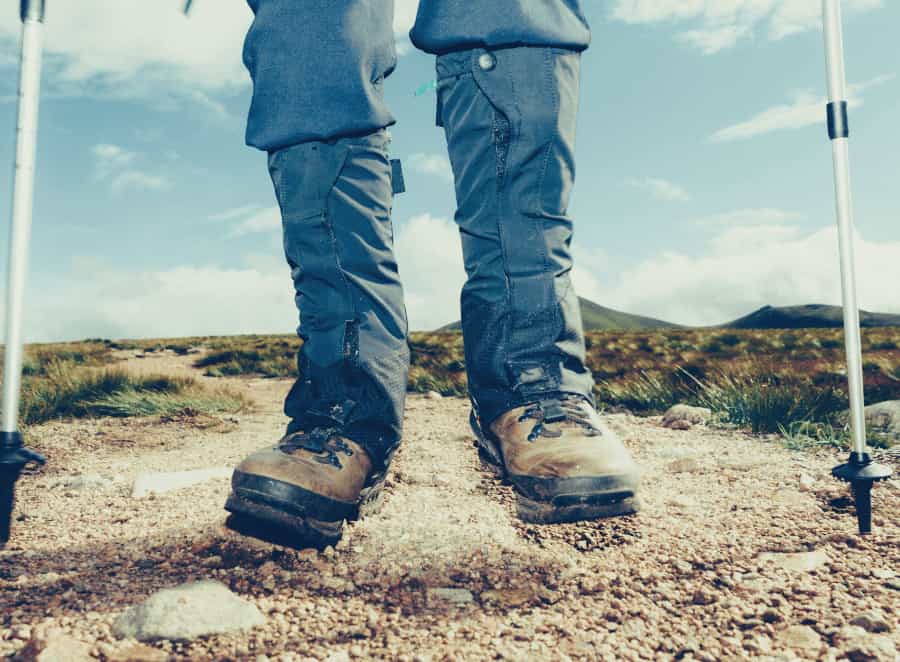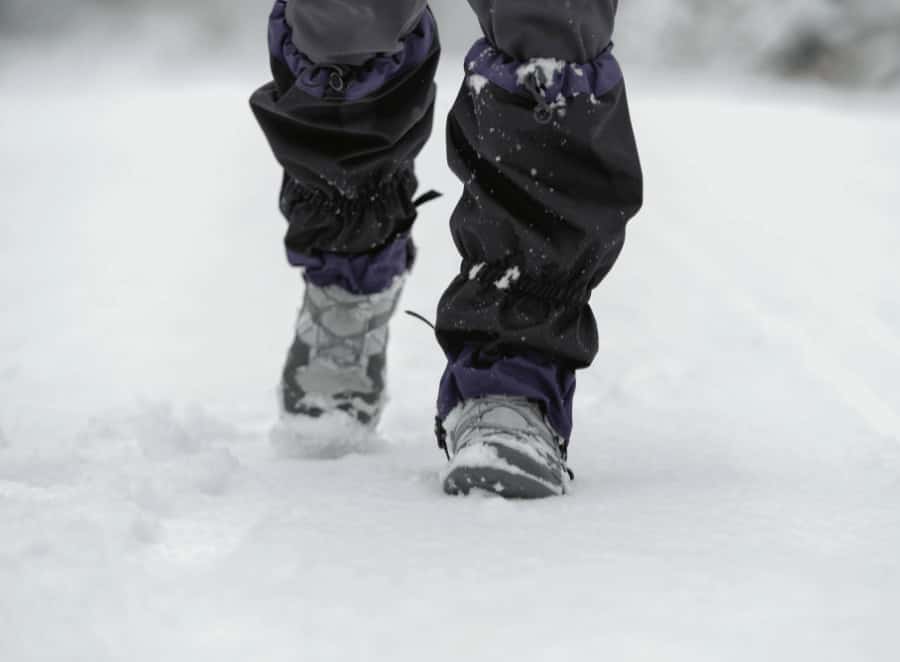Do you need gaiters for hiking? The answer is, it depends.
A gaiter is a fabric guard that covers the gap between your pants and your hiking shoes or boots.
There is a loop on one end that wraps under your heel and the other end wraps around your ankle or calf.
What You Will Learn
So do you need gaiters for hiking?
Most of the time you do not need them, but for very sandy, muddy or wet conditions they can help you maintain dry, clean feet and hopfully avoid blisters and other foot problems from prolonged periods of time hiking.
Read ➡️ My Top Picks for the Best Gaiters for Mountaineering and Hiking
Pros and Cons of gaiters for Hiking
Keep reading to learn the PROS and CONS of gaiters for hiking.
- Protection from debris
- Waterproofing
- Insect Protection
- Durability
- Heat
- Reduced Breathability
- Gets in the Way
- Added Weight
They can be incredibly helpful for any outdoor adventure where there is a lot of mud, snow or loose debris and you want to keep your feet dry.
Also, if you plan to do a coastal hike such as the Fisherman’s Trail in Portugal, you’ll find they help to keep the SAND OUT of your hiking boots.
They can be difficult to put on and not so comfortable, so they are not for every adventure. However, if you’ve been eyeing some bigger treks, multi-day hiking adventures or shoulder season or winter hikes you may want to consider using gaiters for hiking.
Related Reading
🔥🥾 Related Reading: Hiking Advice from a Physical Therapist Hiking Addict:
- Best Microspikes for Winter Hiking
- How to Use Trekking Poles for Longer Hikes
- The Best Hiking Dress for Lady Boss Hikers
- Best Rated GPS Hiking Watches for Soft Hikers and Mountaineers
Pros of Using Gaiters While Hiking
- Protection from debris: Gaiters are designed to keep rocks, dirt, and other debris out of your boots, which can be especially helpful in areas with loose gravel or sand.
- Waterproofing: Gaiters are typically made from waterproof materials that can help keep your feet dry in wet and muddy conditions.
- Additional warmth: In cooler temperatures, gaiters can provide an extra layer of insulation for your legs.
- Insect protection: Gaiters can also help keep insects and other pests from crawling up your legs and into your clothes.
- Durability: Many gaiters are made from tough materials that can withstand wear and tear, making them a long-lasting investment.
Unless you’re wearing birkenstocks for hiking, gaiters can be an essential piece of gear for any hiker. They can provide protection from the elements, add warmth, and prevent debris from getting inside your boots. I would highly recommend investing in a good pair of gaiters for your next outdoor adventure.

Cons of Using Gaiters While Hiking
Cons of Hiking with Gaiters:
- Can be bulky and uncomfortable: Gaiters can add extra weight and bulk to your hiking gear, which can make them uncomfortable to wear for some hikers.
- Difficult to put on and take off: Some hikers find that gaiters can be difficult to put on and take off, especially when you have to adjust them frequently on the trail.
- Not necessary for all hikes: If you’re hiking in dry, rocky terrain or in areas without much debris or water, gaiters may not be necessary and can feel like an unnecessary burden.
- Can trap heat: While gaiters can help keep your legs warm in cooler temperatures, they can also trap heat and make you feel too hot and uncomfortable on warmer days.
- May not be effective against all types of debris: While gaiters can be effective at keeping out smaller debris like dirt and rocks, larger debris like sticks and branches can still find their way into your boots.
It’s important to weigh the pros and cons of gaiters and consider the specific terrain and conditions of your hike before deciding whether to include them in your gear.
Snow Hiking – Do You Need Gaiters?

Wet and snowy conditions are the best application use for gaiters. Using gaiters for hiking is likely to have the most benefit in snowy conditions to help reduce ice, snow and water getting into your shoes or boots.
What are the Types of Gaiters?
Gaiters come in 4 main types.
- Ankle Length
- Mid-Length
- Full-Length
- Snow Gaiters
What are the Features of Gaiters
Gaiters come with key and iconic features, from a stirrup strap to lace hooks. We’ve highlighted each in the image below and briefly explained each one for you:
- Gaiters can be made from synthetic fabrics with a durable water repellent (DWR) finish or a waterproof and breathable membrane. Some gaiters also feature tear-resistant fabric for extra durability.
- Fastenings for gaiters can vary from Velcro on cheaper options to poppers or zips on higher-end models. Zip-fastened gaiters often have a storm flap and waterproof zips for added protection.
- An elasticated pull cord allows you to adjust the fit of the gaiter for a secure and comfortable fit.
- Elasticated ankles are sometimes included in gaiter designs for a closer fit to prevent water from getting in.
- A lace hook may be included on some gaiters to secure them to your shoelaces and optimize their fit.
- Stirrup straps made from nylon or rubber go under the outsole of your walking footwear to keep the gaiters in place. You can adjust the strap using the mechanism on the outside of the boot or gaiter.
😓 Tip: If your knees are like mine and require some TLC a set of hiking poles can really help. Read my review of the best trekking poles based on my experience as a hiker and physical therapist.
Wrap Up
Listen up, fellow adventurer! If you’re planning to take on the snowy or wet terrain on your next hike, gaiters can be a total lifesaver. Not only do they keep your tootsies and lower legs dry and cozy, but they also protect you from all sorts of nasty debris and elements.
But before you go splurging on any old pair of gaiters, make sure to consider the material, breathability, and weight of the bad boys. You don’t want to end up lugging around a pair of gaiters that feel like they weigh a ton, or worse, end up with sweaty, stinky feet from poor ventilation.
Oh, and don’t even think about busting out the gaiters for hiking those short and sweet hikes, my friend. Save ’em for the big leagues!
❤️ YOUR FEET!!!! LEARN ALL MY BEST EXPERT TIPS AND TRICKS TO CARE FOR YOUR FEET WHILE HIKING
- How to Prevent Blisters While Hiking
- Best Hiking Socks for Preventing Blisters
- Tips for Hiking with Plantar Fasciitis
- How to Protect Your Toes Hiking Downhill
- Full Review of the Best Blister Kits for Hiking
- What it’s like to Use Neoprene Socks for Hiking
- Injinji Toe Socks Review
Learn from my almost 3 decades of hiking, running and physical therapy practice.

Author profile: Morgan Fielder is a Doctor of Physical Therapy and passionate hiker who believes in exploring the world on foot with good food. Follow her journey as she shares science-based hiking tips and advocates for sustainable tourism.
MORE HIKING RESOURCES
Get more physical therapist expert hiking tips here 👎🏻
- 🏋️♀️ Ready to take your hiking training to the next level? Learn how to use a weighted vest to boost your endurance and stamina on the trail – read on now!
- Discover the ultimate cheap sleeping solution for your SUV with the Exped Megamat Duo – read my review now!
- 👣 Ready to explore the most breathtaking hut-to-hut hikes in Europe? Check out our top picks now!
- 🌲 Get ready for your next hiking adventure with our comprehensive directory of resources designed to make your hike as comfortable as possible!
